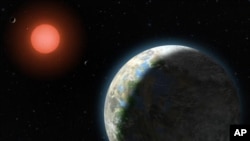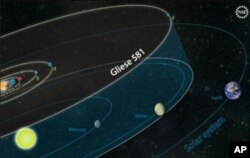Astronomers have discovered a few hundred planets over the years, but Paul Butler of the Carnegie Institution in Washington says the planet he helped discover is different. He and his team of astronomers say this planet, named Gliese 581G, could bear the closest resemblance to Earth of any planet ever discovered.
Butler says this planet is the right distance from the star it orbits in order to possibly support life.
"So the significance of this discovery is that it is the first time we found a planet that has the right mass and is the right distance [from the star it orbits] to have liquid water and a substantial atmosphere," says Butler. "People have been getting closer and closer over the last couple of years. They have been finding planets that are on the hot edge of the habitable zone and on the cold edge of the habitable zone, but finally we have one right in the middle."
This "right in the middle" zone is sometimes referred to as the Goldilocks zone, referring to the title character in the well-known children's story "Goldilocks and the Three Bears."
In that tale, a hungry Goldilocks stumbles upon the home of a trio of bears. While they are away, Goldilocks tries out each of their bowls of porridge, declaring father bear's to be too hot, mother bear's to be too cold and baby bear's bowl to be just right.
Doug Hudgins, an exoplanet exploration program scientist for NASA in Washington, explains what "just right" means in orbital terms.
"The Goldilocks zone is the range of orbits around any star where it is neither too hot nor too cold but just right for liquid water to exist on the surface, and that is a key ingredient for the existence of life," says Hudgins.
Butler says astronomers have identified about 400 planets in the past 15 years. He explains he and fellow planet hunters observed the faint red dwarf star Gliese 581 using one of the world's biggest telescopes at the W.M. Keck Observatory in Hawaii. Since they started observing this star 11 years ago, they have identified six planets that orbit around Gliese 581. But only planet G is the right distance from its star, in that so-called "Goldilocks zone."
"The truly exciting thing about this discovery is that the star is so nearby, and we found it relatively quickly in the scheme of things," says Butler. "So this suggests that potentially habitable planets are very, very common."
"So nearby" is a relative phrase. This new planet is about 193 trillion kilometers away. And "potentially habitable" means the planet could potentially sustain life, but not necessarily life as we know it.
Steven Vogt, a fellow co-discoverer of the planet and a professor of astronomy and astrophysics at the University of California Santa Cruz, explains that the planet's atmosphere remains unknown.
"We don't know exactly what the atmosphere is composed of. I mean if the atmosphere is pure ammonia, it might be tough. If it's conventional gases like oxygen and carbon dioxide, that sort of thing, sure, there is every bit of reason to think that life as we know it could exist there," says Vogt. "But without knowing in detail what the atmospheric constituents are, what is the balance of nitrogen and oxygen that sort of thing, we may have to bring our own atmosphere with us or manufacture it."
This newly discovered planet has a mass about three-to-four times that of Earth. And it is locked into position with its star, so one side is always in dark and one side always in light. And, as far as orbits go, Gliese 581G's 37-day orbit around its star is far shorter than the 365 days it takes our planet to orbit the Sun.
"When you listen to that you think, 'Wow! That must be way too close to the star for there to be life because that is a short orbit. So this is shorter than the orbit of Mercury around our own Sun. It must be terribly hot.' Actually, that is not the case," says Doug Hudgins of NASA's exoplanet exploration program,
He says Gliese 581 is a red dwarf star that is much cooler than our Sun and emits far less radiation.
Hudgins explains, "In fact, those planets need to snuggle up a lot closer to that star in order to get the warmth. So in fact the habitable zone around Gliese 581 is much closer to the star than in our own solar system."
Planet co-discoverer Vogt acknowledges that finding a possibly Earth-like planet raises the question of whether there are other lifeforms in the universe.
"And so we are trying to answer that by finding places where life, as we know it, can exist, and if we do find places where we know life exists, it will tell us a lot more about how we fit into the hierarchy of life in the universe," says Vogt.
The research was supported by grants from NASA and the National Science Foundation. The findings of Butler, Vogt and the rest of their team is published in the Astrophysical Journal.






